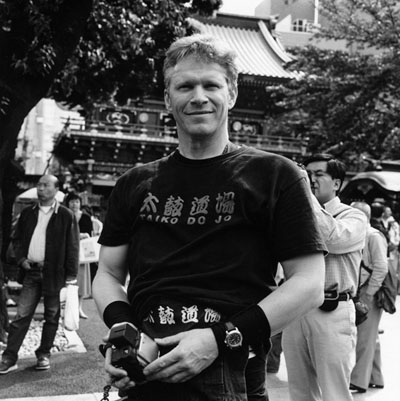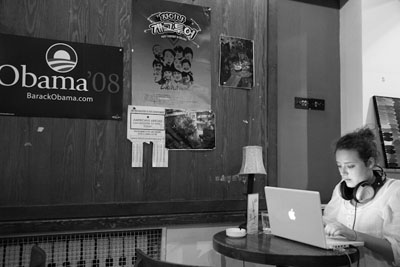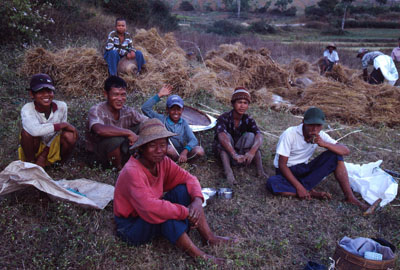About
My name is Hitoshi Kameyama.
I was born in Tokyo, Japan on December 7, 1966 and now I reside in Kanagawa, a neighboring prefecture to Tokyo.
I am a photographer taking the human drama.
[Early Days]
My first experience with photography was when I was a grade school student. I wanted to take pictures of a train that I was interested in at that time. I brought my half-sized film camera called Olympus Pen from home and took pictures at the Ueno Station in Tokyo. Though I hardly remember the photographs that I took, what impressed me the most was that camera was a mysterious machine that can take an incredible number of seventy-two photos.
I may have been interested in the camera more than the photograph. When I was in high school, the Olympus Pen broke so I bought a SLR camera called Olympus OM2. I took the photographs of my classmates at school events such as excursion and cultural festivals. I felt really happy when they thanked me for giving the photographs but I had not considered taking an artwork.
In my twenties, I had almost forgotten about the camera and photography. As I entered in the early thirties, I got married, bought a house, and settled down. I thought to have a hobby that differs from work, help me change pace and can continue for a long time. After a long time separation, I held a camera magazine at a bookstore. I was surprised to know the dramatic change in SLR cameras from that of the OM2's era. Unlike sports, I felt I could continue this hobby even if I become old and I assumed that I could shoot a beautiful photograph if I obtained a new camera.
[Evolvement]
In 2001, I studied the composition of photography and the basic exposure skills from an advertising photographer, Masato Tashiro. I leant many techniques without depending on an automatic setting of a camera like manual setting of exposure to match the creative objective, composition utilizing the leading and the supporting objects, and such. At that time I could have been aiming to take a beautiful scenic shot like that of a poster and a calendar taken by renowned photographers. However, I was feeling impatient of not coming close to the scenic shot of popular beauty in postcard and poster of a local souvenir shop. Also, it was impossible to come across an ideal imagery if the weather condition was bad.
In 2003, when I was on a shooting trip in Biei, Hokkaido, I saw an album made by a female staff of a B&B. The album consisted of service-sized photographs of landscape taken with a SLR camera for beginners. I was overwhelmed by the beauty and strength of the pictures. It made me realize the importance of living on the spot and also the limitation of creating a work in the landscape photography.
One day, a friend of mine showed me a photograph in black-and-white. Until then, I had thought that black-and-white photograph was out dated. He told me that it could be done by one self; shooting, developing films, and enlarging prints. There are many techniques involved in printing: dodging, burning, and contrast adjustment, etcetera. One could enjoy twice, shooting and printing monochromes. I held a strong interest in monochrome snapshot from the story of my friend. His story on snapshot was grounded on his experience about the joy and difficulty of capturing the exact moment in movement of people and matters. Subsequently, I built a private darkroom and I started to take monochrome snapshots.
My shooting objects changed from scenery to snapshot of people. As I liked to travel by nature, I started to travel to foreign countries to take photographs. The people in Bali, where the center of their daily lives was religion, moved me. Also, when I made my first visit to Europe, to the city of Prague in Czech Republic, I was deeply impressed by the quietness of the mediaeval city that looked beautiful in black-and-white photographs. Thereafter, I had been to many foreign countries like China, England, France, Denmark and Canada.
In 2004, I enrolled in a workshop held by Satoru Watanabe. At the workshop, I learnt not only the skills on shooting and the darkroom process but also the appreciation of work and the importance of the selection over taking photographs. Moreover, at the group exhibition upon the completion of the workshop, I learnt the difficulty and the importance of the caption through preparing it for my work.
[Theme]
My theme in photography is to convey attraction and humor of mankind.
[Objects]
My object is the conscious and unconscious act of human drama. Individuals have characters of their own and corresponding lives. I believe religious beliefs, native cultures, families and friends that surround each individual formed people. In the society where people live, harmony and friction, and sometimes collision occur. Those human dramas are the source of fun and joy, and sometimes sorrow and anger in our lives. I am intrigued by the drama and I fell humor and irony in them. I try to reproduce the drama through snapshots. I assume that I might be confirming what I desire to become or not to become. Through taking portraits, I may be seeking to get understanding and sympathy from others as well as to compliment my shortcomings.
Travel Photo-Log and L'Etranger series
When I am on a shooting trip to a foreign country, I occasionally visit famous sightseeing spots. However, when I have a camera, I prefer to go to the place where I can feel life of a local people. It is a joy to walk in to supermarkets and shopping streets and take pictures of where the local people buy the foodstuffs every day. I believe it is because I am interested in people who live in the social environment that differs in sense of religion and language from me. Therefore, I am roaming for the place where the difference could be felt. Although I do not talk to a stranger in Japan, while on a trip, I converse with a person in a queue at a bus stop and with someone I happened to sit across the train. Regardless of the language barrier, I enjoy the conversation. However, I feel anxiety and loneliness when I am lost or when neither expected train nor bus shows up. Likewise, sometimes a faint feeling of fear of behaving strange in the eyes of local people crosses my mind.
One day, when I was taking a snapshot in Kanda-shrine in Tokyo, a foreigner asked me to press the shutter release button of his camera. He wore a tee-shirt with a Japanese character "Taiko-Dojo," meaning Drum School in English printed on the front. After answering to his request, we had a conversation. He said he came from Germany on a business trip three days ago and today was his day-off. He will return home in three days but wanted to come back to Japan on a vacation. The word that he said at the end remained in my mind: " I am amazed to find myself talking with you in Japan because I hardly talk to strangers in my country." I took his picture with my camera.

At that very moment, I figured that he sympathized with what I had also felt in foreign countries. Ever since then, I started to take snap-shots of foreign travelers, assuming that I might be able to capture the same uplift, loneliness and sense of difference from the usual being that I feel in foreign countries. Ever since then, as a reversal of this theme, I have been taking pictures of the impression of the people living there and the cultural climate as the Travel Photo-Log series.

Myanmar series
In the autumn of 2005, having learned that my mentor Satoru Watanabe was recruiting the participants for a photo-shooting trip to Myanmar, I joined the party. Energetic eyes and gentle smile of people I met there were impressive and I appreciated the happiness and joy in taking photographs. I visited Myanmar several times after this trip to take portraits and snapshots of the people. Whenever I visit Myanmar, I give away the photographs I took on a previous visit to the people for allowing me to take their pictures. They express deep gratitude to me for just a piece of photograph. The photographs taken are given as presents. This has become my basic practice in photography.
One day, as I viewed the gathering of the family and neighbors having a supper through the finder, it overlapped with my memory from my childhood days and reminded me that I also was there. Through seeing them help and support one another, it seemed as though they still held the modest sense of happiness and kindness that Japanese society in recent days has lost in exchange to the loneliness and anxiety.

I long to recognize my shortfall and what I should be through seeing and exchanging with them. Likewise, I wish to capture their unfailing vitality as well as their pray and belief in the future prosperity despite the many hardship of life.
[Photographic Style & Equipments]
I use the color and monochrome accordingly with the shooting purpose. As for shooting in color, I mainly use digital camera to record visible beauty and the image created by harmony of color. With digital, result can be confirmed instantaneously on the spot. This is very convenient for me; I take a photograph of someone and I can show it after shooting. DSLR becomes a good communications tool and provides assurance for giving the result afterwards.
I employ the negative film for back-and-white and it is used for self-remembrance of impressive object. Despite negative film fears me of making a mistake, I feel the response in shooting and expectation for the miracle to happen from a coincidence. When I recollect an impressive person or a scenery, oftentimes, the expression on ones face and the shape are clearly remembered but the color information is uncertain. It is the feeling of remembrance as the image appears on the printing paper treated in developer bath in the darkroom. This is one of the reasons why I think monochrome is easier to create work to meet the intended theme.
Today, most of my works are shot in monochromes. I think that it is vital to capture the wavering of emotions in order to express my theme in human drama. I assume that although emotions coming out of a person are not visible but can be conveyed through their expression and movement. I believe that simple monochrome photograph without color is most suitable to depict the theme in the simplest form.
[Future Projects]
In 2008, I held a first solo exhibition of Myanmar photograph collections in color. I was given many receptions from the guest. It was quite a valuable experience to hear how they felt and what they thought of my work. For the next time, I am planning to hold a solo exhibition of my portrait works in monochrome.
Concurrently, I would like to continue taking the Travel Photo-Log and L'Etranger Series of works and I hope to make an opportunity to exhibit them. I plan to extend the objects from European and American to Chinese and South Koreans that have been impacting the Japanese culture.
[After Note]
In Myanmar, I am taken care of by a person named Ms. Ann. She serves as the representative of the Buddhist temple in the Inlay Lake and manages the hotel and the restaurant. She is a magnate of the Inthar tribe, one of the minorities in the state of Shan. She is also active in building schools, orphanages and hospitals sourced by the profit obtained from her business. I assume that this is her way of doing the virtue. Ms. Ann was sympathized at first by Dr. Tanaka of Bangkok, Thailand. He acts as intermediary between Ms. Ann and Japan, or rather with the world. The future of Myanmar is the cause for his vigorous activity and organizing the event.
I was moved by their way of thinking and their actions, and my sympathy is with their activities. I desire to make a contribution and support by doing things on my own, which I believe is my way of doing the virtue. Myanmar was seen by the world with negative image due to the military-led government and the captivity of Aung San Suu Kyi. However, the killing of a Japanese journalist in the massive demonstration had worsened the image and had caused sharp decrease in number of tourist visiting the country. Tourism had been the key industry in the underdeveloped country but the situation has become disastrous. I aim to release my work on the unsophisticated kindness of the people, beautiful landscapes no less than that of the other countries and the remains of ancient Buddhist temples, in hope for gaining more attention to Myanmar and increase the number of visitors to this country.
[Publications]
2013 Photo Book "Thanaka" Tosei-sya Tokyo, Japan
photo-eye book store Amazon.jp IMA-online.jp
[Exhibitions]
Solo Exhibitions:
2013 "Thanaka" Tokyo, Japan
2011 "Village on the water" Tokyo, Japan
2008 "The Corridors of Water," Tokyo, Japan and Heho Airport, Myanmar
2007 "Myanmar Tells Me, " Inle Lake, Myanmar
2012 "Monochrome V" Tokyo, Japan
2011 "Monochrome IV" Tokyo, Japan
2007 "Tabi - Uki-sei-ko," Tokyo, Japan
2006 "Friends" Tokyo, Japan
2005 "Traveling Myanmar 2005," Tokyo, Japan
2005 "In Our Eyes," Tokyo, Japan
2004 "Friends," Tokyo, Japan
2003 "Friends," Tokyo, Japan


